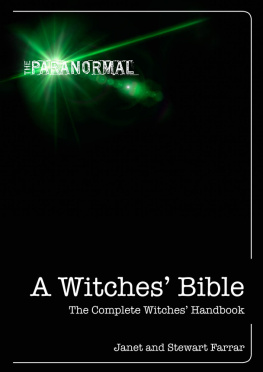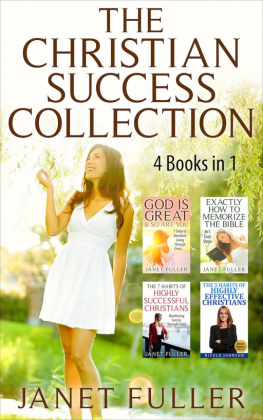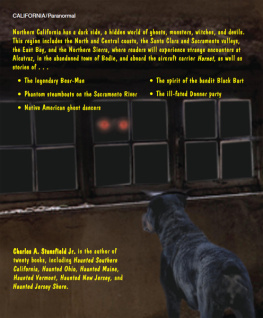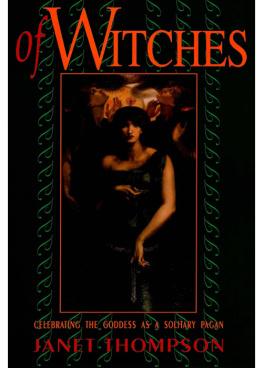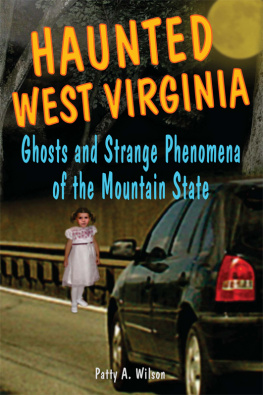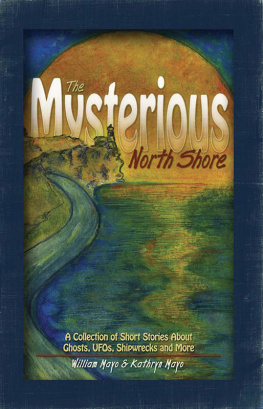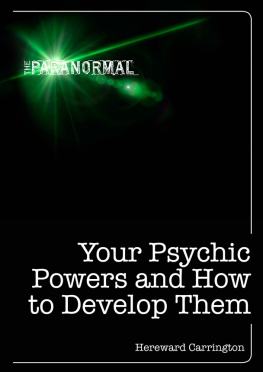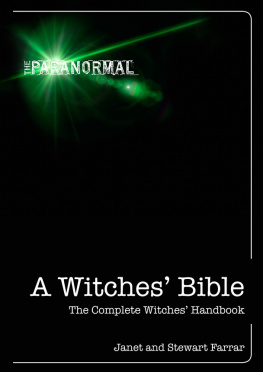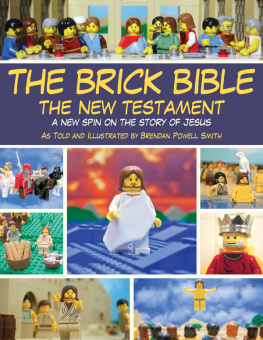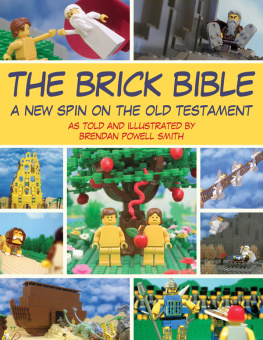Janet - A Witches Bible
Here you can read online Janet - A Witches Bible full text of the book (entire story) in english for free. Download pdf and epub, get meaning, cover and reviews about this ebook. year: 2012, publisher: F+W Media, genre: Religion. Description of the work, (preface) as well as reviews are available. Best literature library LitArk.com created for fans of good reading and offers a wide selection of genres:
Romance novel
Science fiction
Adventure
Detective
Science
History
Home and family
Prose
Art
Politics
Computer
Non-fiction
Religion
Business
Children
Humor
Choose a favorite category and find really read worthwhile books. Enjoy immersion in the world of imagination, feel the emotions of the characters or learn something new for yourself, make an fascinating discovery.
- Book:A Witches Bible
- Author:
- Publisher:F+W Media
- Genre:
- Year:2012
- Rating:4 / 5
- Favourites:Add to favourites
- Your mark:
- 80
- 1
- 2
- 3
- 4
- 5
A Witches Bible: summary, description and annotation
We offer to read an annotation, description, summary or preface (depends on what the author of the book "A Witches Bible" wrote himself). If you haven't found the necessary information about the book — write in the comments, we will try to find it.
Janet: author's other books
Who wrote A Witches Bible? Find out the surname, the name of the author of the book and a list of all author's works by series.
A Witches Bible — read online for free the complete book (whole text) full work
Below is the text of the book, divided by pages. System saving the place of the last page read, allows you to conveniently read the book "A Witches Bible" online for free, without having to search again every time where you left off. Put a bookmark, and you can go to the page where you finished reading at any time.
Font size:
Interval:
Bookmark:


with line illustrations by Stewart Farrar
and photographs by Ian David & Stewart Farrar
To our dear friend
KATH DEATH, ne CARTER
(190576)
And ye shall meet, and know,
and remember,
and love them again.
I wish there were some way of reconciling formal education and natural knowing. Our inability to do this is a terrible waste of one of our most valuable resources. There is a fund of knowledge, a different kind of information, common to all people everywhere. It is embodied in folklore and superstition, in mythology and old wives tales. It has been allowed to persist simply because it is seldom taken seriously and has never been seen to be a threat to organized science or religion. It is a threat, because inherent in the natural way of knowing is a sense of rightness that in this time of transition and indecision could serve us very well.
Lyall Watson, Gifts of Unknown Things
If we are to get out of the mess to which civilized ignorance has brought us, we must prepare ourselves, in some ways at least, for the return of paganism.
Tom Graves, Needles of Stone
We would like to thank Doreen Valiente for her invaluable help in providing information, for permission to reproduce several ritual passages which she herself wrote for Gardners Book of Shadows, and for reading our manuscript before publication.
We are grateful to Messrs. Faber & Faber for permission to quote extensively from Robert Graves The White Goddess.
We are also grateful to the Society of the Inner Light for permission to use passages from Dion Fortunes The Sea Priestess as part of our Handfasting Ritual.
All photographs are by Ian David, with the exception of Numbers 11 and 15, which are by Stewart Farrar.
Modern witchcraft, in Europe and America, is a fact. It is no longer an underground relic of which the scale, and even the existence, is hotly disputed by anthropologists. It is no longer the bizarre hobby of a handful of cranks. It is the active religious practice of a substantial number of people. Just how large a number is not certain, because Wicca, beyond the individual coven, is not a hierarchically organized religion. Where formal organizations do exist, as in the United States, this is for legal and tax reasons, not for dogmatic uniformity or the numbering of members. But the numbers are, for example, enough to support a variety of lively periodicals and to justify the publication of an ever-growing body of literature, on both sides of the Atlantic; so a reasonable estimate would be that the active adherents of Wicca now number tens of thousands, at the very least. And all the evidence suggests that the number is growing steadily.
Wicca is both a religion and a Craft aspects which Margaret Murray has distinguished as ritual witchcraft and operative witchcraft. As a religion like any other religion, its purpose is to put the individual and the group in harmony with the Divine creative principle of the Cosmos, and its manifestations, at all levels. As a Craft, its purpose is to achieve practical ends by psychic means, for good, useful and healing purposes. In both aspects, the distinguishing characteristics of Wicca are its Nature-based attitude, its small-group autonomy with no gulf between priesthood and congregation, and its philosophy of creative polarity at all levels, from Goddess and God to Priestess and Priest.
This book is concerned with the first aspect Wicca as a religion, ritually expressed.
Witches, on the whole, enjoy ritual and they are naturally joyous people. Like worshippers of other religions, they find that appropriate ritual uplifts and enriches them. But their rituals tend to be more varied than other faiths, ranging from the formal to the spontaneous and differing also from coven to coven, according to their individual preferences and the schools of thought (Gardnerian, Alexandrian, Traditional, Celtic, Dianic, Saxon and so on) on which they have based themselves.
But as the twentieth-century Wiccan revival matures (and in many covens passes into its second generation), the inter-school acrimony which marred its early years has considerably diminished. Dogmatists still slang each other in the periodicals but increasingly their dogmatism is condemned by other correspondents as pointlessly disruptive; and most ordinary covens are simply bored by it. The years have taught them that their own path works and if (like our own coven) they have friends of other paths, they have also come to understand that those paths work too.
Out of this greater mutual tolerance has grown an increased awareness of Wiccas common basis, its essential spirit which has little to do with the details of form. Also, with the exchange of ideas both through the printed word and through more open personal contact, there is a growing body of shared tradition on which everyone may draw.
It is as a contribution to this growth that we offer our present book. To be valid, and useful, any such contribution must be a branch arising healthily out of the parent trunk of our racial history, as well as the specific forms of Wiccan practice as it now stands (in our case, the Gardnerian/Alexandrian forms); and this is what we have worked to achieve.
Fortunately, a framework exists which is common to all Wiccan paths, and indeed to many others: the Eight Festivals.
The modern witches calendar (whatever their school) is rooted, like that of their predecessors through untold centuries, in Sabbats, seasonal festivals which mark key points in the natural year, for Wicca, as we have stressed, is a Nature-oriented religion and Craft. And since, for witches, Nature is a many-levelled reality, their natural year includes many aspects agricultural, pastoral, wildlife, botanical, solar, lunar, planetary, psychic the tides and cycles of which all affect or reflect each other. The Sabbats are the witches way of celebrating, and putting themselves in tune with, these tides and cycles. For men and women are also a part of many-levelled Nature; and witches strive, consciously and constantly, to express that unity.
The witches Sabbats are eight:
IMBOLG, 2nd February (also called Candlemas, Oimelc, Imbolc).
SPRING EQUINOX, 21st March (Alban Eilir).
BEALTAINE, 30th April (Beltane, May Eve, Walpurgis Night, Cyntefyn, Roodmass).
MIDSUMMER, 22nd June (Summer Solstice, Alban Hefin; also sometimes called Beltane).
LUGHNASADH, 31st July (August Eve, Lammas Eve, Lady Day Eve).
AUTUMN EQUINOX, 21st September (Alban Elfed).
SAMHAIN, 31st October (Halloween, All Hallows Eve, Calan Gaeaf).
YULE, 22nd December (Winter Solstice, Alban Arthan).
Of these, Imbolg, Bealtaine, Lughnasadh and Samhain are the Greater Sabbats; the Equinoxes and Solstices are the Lesser Sabbats. (The actual dates of Equinoxes and Solstices may vary by a day or two in traditional usage, and also from year to year in astronomical fact, while the Greater Sabbats tend to involve both the Eve and the following Day.) The solar-astronomical Lesser Sabbats are both older and newer than the natural-fertility Greater Sabbats older, in that they were the highly sophisticated preoccupation of the mysterious Megalithic peoples who pre-dated Celt, Roman and Saxon on Europes Atlantic fringe by thousands of years; newer, in that the Celts perhaps the biggest single influence in giving to the Old Religion the actual ritual shape in which it has survived in the West were not solar-oriented and celebrated only the Greater Sabbats, until what Margaret Murray has called the solstitial invaders (the Saxon and other peoples who swept westward with the decay of the Roman Empire) met and interacted with the Celtic tradition. And even they brought only the Solstices: The Equinoxes, says Murray, were never observed in Britain. (For some thoughts on how they subsequently entered British folklore and remember that, since Murray, more has been learned about Megalithic astronomy, which may well have left buried folk-memories to be revived later.)
Font size:
Interval:
Bookmark:
Similar books «A Witches Bible»
Look at similar books to A Witches Bible. We have selected literature similar in name and meaning in the hope of providing readers with more options to find new, interesting, not yet read works.
Discussion, reviews of the book A Witches Bible and just readers' own opinions. Leave your comments, write what you think about the work, its meaning or the main characters. Specify what exactly you liked and what you didn't like, and why you think so.

